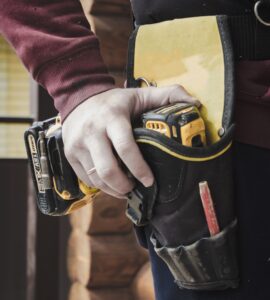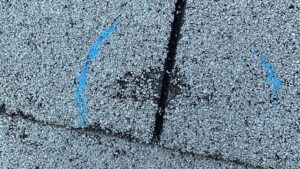Ceiling cracks aren’t unusual. In fact, some cracking is considered normal and should even be expected. you only need to act quickly and call a roofing company if water spots appear with the crack.
Cracks in your ceiling can emerge from normal factors like the house settling or paint drying out. However, cracks can also indicate serious problems, like excess moisture or structural damage.
So, how do you know which cracks can be ignored and which ones must be repaired?
This guide will fill you in. It provides an overview of the main reasons ceilings crack, what common ceiling cracks can mean, and which ones must be addressed.
Top Reasons Ceilings Crack
Ceilings often crack due to moisture or aging. Sometimes ceilings crack due to interior structural and construction issues. However, weather issues like heavy snow, high winds, or intense rainfall can be responsible.
Poor Construction of Ceiling or Roof Installation
A faulty roofing installation or home construction can cause structural or cosmetic ceiling cracking. For example, shoddy drywall installation can lead to cosmetic ceiling cracks.
Aging of Ceilings or Roof
Ceiling cracks sometimes appear because of paint or plaster drying out over time. It can also appear due to age-related structural movements.
House’s Foundation Settling
Homes settle into place. Settling primarily occurs after a new home is built, with age, or because of soil issues.
Age-related settling cracks are most common with newly built and older homes. This is considered normal and isn’t typically an issue.
However, a foundation can shift and settle more than normal due to waterlogged soil after intense rainfall or flooding. It can also move out of place if the soil dries out too much.
Roof Movement/ Wear
Cracks in ceiling can emerge when the roofing structure shifts or moves. The roof and its trusses (wooden framework supporting it) can move due to high winds or climate changes. This is called truss uplift.
Roofs can move in response to temperature and humidity fluctuations. That usually isn’t a big deal.
However, roof movement after high winds should always be taken seriously.
Heavy Upper Floors
Excess weight on the roof or floor can cause the ceiling beneath to bow or sag.
What Do Spiderweb Ceiling Cracks Mean?
Spiderweb cracking radiating out from a central point indicates foundation settling. Some settling is normal excessive building movement is problematic.
So look for settling-related red flags, like sticking doors, sticking windows, or sloping floors. Call a roofing inspector if anything seems amiss.
What Do Hairline Ceiling Cracks Mean?
Fine, hair-thin straight or spiderweb ceiling cracking is usually just the paint or plaster. Paint and plaster can crack with age, from humidity, or in response to normal settling.
This isn’t usually a big deal on its own. But keep an eye on things and watch for red flags.
What Does a Horizontal Crack Between the Ceiling Wall and Ceiling Mean?
A horizontal crack running between or along the ceiling and wall can be due to foundation settling or truss uplift from high winds.
These cracks can be fine, but it’s a good idea to have them looked at.
What Do Vertical Ceiling to Wall Cracks Mean?
A crack running across your ceiling and down the wall indicates structural damage. This is a red flag that needs to be evaluated ASAP.
What Do Cracks on a Flat Roof’s Ceiling Mean?
Have a flat roof or roof section? Flat roofs are more prone to water issues and can be damaged more easily than pitched roofs.
It might not be a big deal, but these cracks should always be checked out.
What Do Large Cracks on a Bowed or Sagging Ceiling Mean?
A bowed or sagging ceiling is bad news – especially when accompanied by a crack or cracks.
This is serious. It indicates some form of structural damage that may already be quite advanced.
Contact a roofing professional immediately.
What Do Plaster Ceiling Cracks Mean?
Plaster is prone to cracking over time. So, cracking on a plaster ceiling usually isn’t a big deal. You might not have anything to worry about if you only see cracking or flaking, without any discoloration or larger cracks.
What Do Discolored Yellow or Brown Ceiling Cracks Mean?
Yellow, brown, or otherwise discolored ceiling cracks are signs of water damage and leaks.
This needs to be addressed. If the damage is the highest floor of your home or in your attic schedule a roof inspection with a local roofing company, all roof inspections from reputable roofing companies are always free.
Both the crack and the leak must be taken care of. Cracks that would otherwise be a minor issue can be far more dangerous if water damage is present. And leaking water will always compromise your house’s integrity.
The leak could be coming from plumbing, a faulty roof, or another source.
What Kind of Ceiling Cracks Might be a Sign of Roof Damage?
Ceiling cracks must be taken care of immediately when there is structural damage, loss of building integrity, leaks, excess moisture, or roofing problems. The following can be considered signs of trouble.
Ceiling cracks after:
- Heavy snow
- Heavy Rainfall
- Flooding
- Earthquakes
- Droughts
Ceiling cracks with:
- Sagging
- Discoloration
- Sticking Doors or Windows
- Sloping Floors
- Extended cracking down the wall
Does your house have ceiling cracks and sagging, discoloration, or accompanying cracks down the wall? Are any doors or windows sticking when you try to open them or hard to shut?
Those are major red flags! Contact a qualified roofing professional to inspect your ceiling and attic.
Get a Professional Roof Inspection
Ceiling issues aren’t to be taken lightly. So reach out to us at Canopy Roofing & Solar for emergency inspections, or if you have any concerns.
Our professional team members are experienced in inspecting, installing, repairing, and restoring both residential and commercial roofs. Contact us and we’ll send a senior team member over to do a thorough evaluation.
Not sure if it’s a big deal? Reach out to us anyways. It’s much better to be safe than sorry, and it’s always a good idea to have a professional determine how bad a ceiling crack is or isn’t.
Just send us a message.





